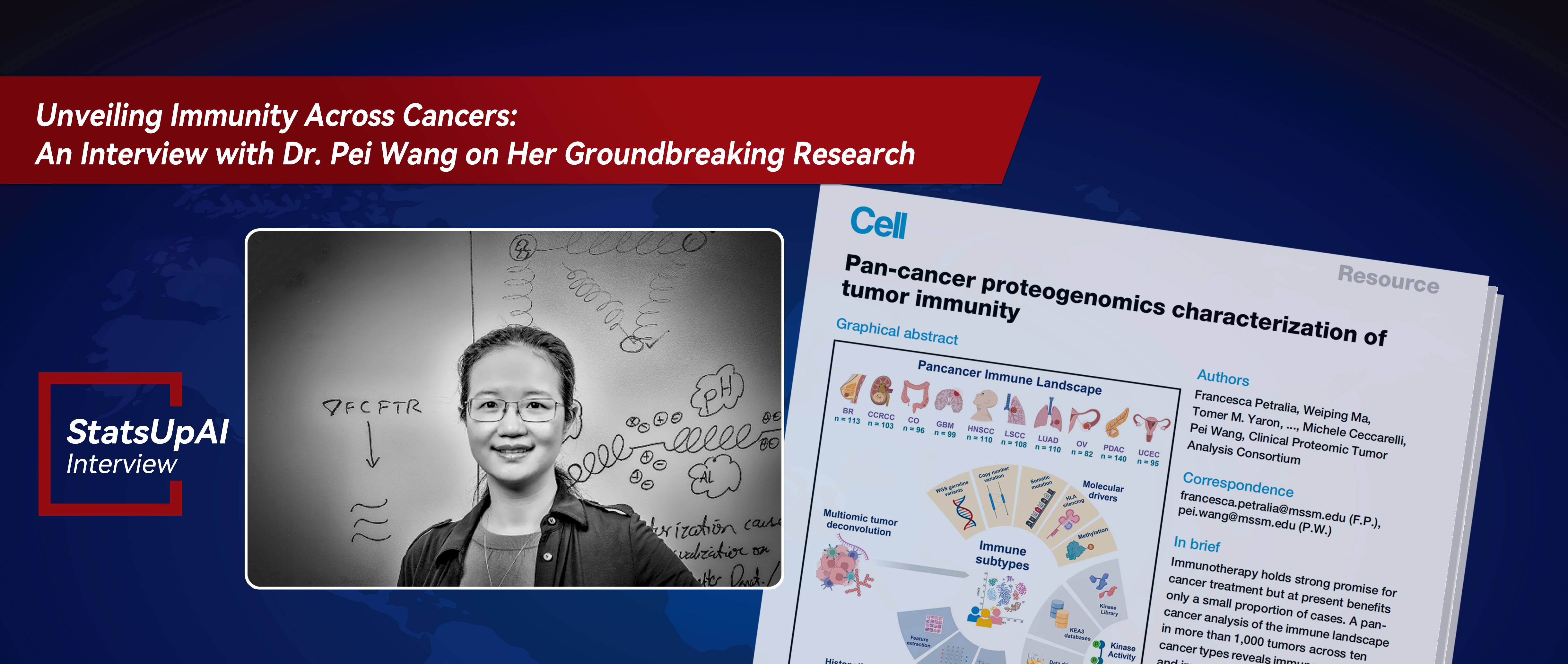Unveiling Immunity Across Cancers: An Interview with Dr. Pei Wang


Dr. Pei Wang
Dr. Pei Wang is a Professor of Genetic and Genomic Sciences at Icahn School of Medicine at Mount Sinai, New York. She obtained her B.S. in Mathematics from Peking University, China, in 2000; and her Ph.D. in Statistics from Stanford University in 2004. Between 2004-2013, Dr. Wang held faculty positions in the Program of Biostatistics at Fred Hutchinson Cancer Research Center and the Department of Biostatistics at the University of Washington, Seattle, WA. In Oct 2013, Dr. Wang joint Icahn Medical School at Mount Sinai, New York.
Dr. Wang's research is dedicated to advancing statistical and computational methodologies, translating vast datasets related to diseases such as cancer into meaningful insights to help with patient treatment. She serves as the Principal Investigator of the NCI Clinical Proteomic Tumor Analysis Consortium (CPTAC), focusing on unraveling the molecular underpinnings of cancer through extensive proteome and genome analyses. Leading the CPTAC Proteogenomics Data Analysis Center at Mount Sinai, Dr. Wang's team strives to identify potential biomarkers and drug targets for cancer, thereby accelerating progress in cancer research.
The Article Link:
Pan-cancer Proteogenomics Characterization of Tumor ImmunityRegarding the research background and significance, does this work discover new knowledge or solve existing problems within the field? Please elaborate in detail.
Dr. Pei Wang: This work discovered new knowledge. In our paper “Pan-Cancer Proteogenomics Characterization of Tumor Immunity” (Cell, 2024, Feb, PMID: 38359819), we integrated DNA, RNA, and proteomics data derived from more than 1,000 tumors across 10 different cancers to reveal the complex interplay of immune and tumor cells. The data came from the Clinical Proteomic Tumor Analysis Consortium (CPTAC), a program under the National Cancer Institute. This work aimed to improve our understanding of the mechanisms underlying the functional impairment of immune response in tumors. By closely examining genes and proteins in the tumor tissues, we discovered various patterns in immune activation and suppression, and unraveled diverse immune subtypes.
How did the reviewers evaluate (praise) it?
Dr. Pei Wang: The reviewers described the study “current, highly impactful and well developed” with “technical rigor in its methodology and data analysis”, and suggesting that “the key findings advance our understanding of the immune landscape in various cancers and provide potential targets for therapeutic interventions”.
If thisachievement has potential applications, what are some specific applications it might have in a few years?
Dr. Pei Wang: The findings from the paper can help clinicians to identify patient groups more responsive to immunotherapy. Revealing the specific pathways and cellular switches for each subtype can also spark new and creative ways to develop treatments. For example we nominated a set of kinases that are potential targets for converting cold tumors into hot tumors, thus enhancing their responsiveness to immune-based treatments. We hope some of those leads can be investigated further and be carried out into clinical trials in the future.
Can you recount the specific steps or stages from setting the research topic to the successful completion of the research?
Dr. Pei Wang: I have been leading a data analysis center for NCI Clinical Proteomics Tumor Analysis Consortium (CPTAC) in the past 8 years. Throughout this period, the CPTAC consortium has generated an extensive collection of large-scale, deep proteogenomics data sets. This invaluable resource has offered us a unique opportunity to conduct, for the first time, large-scale (with >1000 tumor samples) proteogenomic analyses to understand the immune landscape across 10 cancer types. Especially, the pan-cancer phosphoproteomics data enables us to comprehensively characterize the kinase activities relating to different immune activation and evasion patterns in tumor samples. This aspect, which has not been extensively explored in prior genomics studies, significantly enhances our understanding of the immune landscape in cancer. In this study, unlocking meaningful biological signals from the vast sea of data required meticulous attention to comprehensive data preprocessing, encompassing quality control and harmonization. Employing sophisticated statistical modeling and rigorous inference techniques is also vital to ensure the extraction of genuine and relevant biological insights. Over the course of more than a year, consortium members, comprising multiple teams from different institutions, collaborated to meticulously assemble, quality-check, and harmonize datasets from various CPTAC cancer studies. Confronting challenges inherent in data analysis, we also undertook the development and enhancement of multiple data analysis pipelines to optimize the analytical process. Another important component for the success of the study is that we are able to work very closely with pathologists and clinicians to interpret the results and obtain additional experiment evidence to validate the data analysis results. It’s truly a team work of researchers from different disciplines.
Were there any memorable events during the research? You can tell a story about anything related to people, events, or objects.
Dr. Pei Wang: Unforgettable moments unfolded when unexpected and significant findings emerged from the study. Out of the seven identified subtypes, five encompassed tumors from 10 distinct cancer types, suggesting shared immune responses across these tumors. Additionally, we noted similar kinase activation patterns across different cancers within the same immune subtype. This implies the potential applicability of specific immunotherapy treatments to a broad spectrum of cancer types. Another surprising finding is that, in one subtype (CD8-IFNG+), despite high activity in the IFNG pathway, there was a surprising observation of low immune cell infiltration. This is unexpected, as an active IFNG pathway is typically associated with a robust immune response. Alternative treatment will be needed for this group of patients compared to those from CD8+IFNG+.
Is there a follow-up plan based on this research? If so, please elaborate.
Dr. Pei Wang: We are seeking opportunities to validate our findings through the analysis of cellular level proteomic/transcriptomic data from cutting-edge single-cell platforms. Furthermore, we intend to leverage the insights garnered from this paper in other clinical studies focused on immunotherapy treatment. This effort aims to streamline the development of biomarker panels for treatment responses and identify enhanced treatment strategies. To exemplify, in collaboration with other CPTAC scientists, I am actively involved in a proteogenomic study aimed at unraveling the intricate molecular mechanisms that underlie responses to immune checkpoint treatments in melanoma patients.
Without a doubt, AI is one of the hot topics of 2023, requiring extensive data support in its development. What assistance can biostatistics offer to the development of AI?
Dr. Pei Wang: I don’t think our work relating to “AI” --- which, in my opinion, involves “self-learning” at real time. But this is definitely a work of BIG data. I believe statisticians play a pivotal role at the forefront, leveraging data to enhance our understanding across a myriad of fields.
Besides the above questions, is there anything else about this achievement that you would like to add? If so, please add it below.
Dr. Pei Wang: One challenge in cancer research is the extensive sample heterogeneity, both within and across different cancers. With the CPTAC Pan Cancer cohort (>1000), we were more powered to reveal unique subtypes not detected in individual cancer studies. Nevertheless, we may not exhaustively identify every potential immune subtype present in these tumors. Also, tumors may exhibit a spectrum of immune infiltration that defies easy categorization into discrete subtypes.
Proofread by: Hongtu Zhu